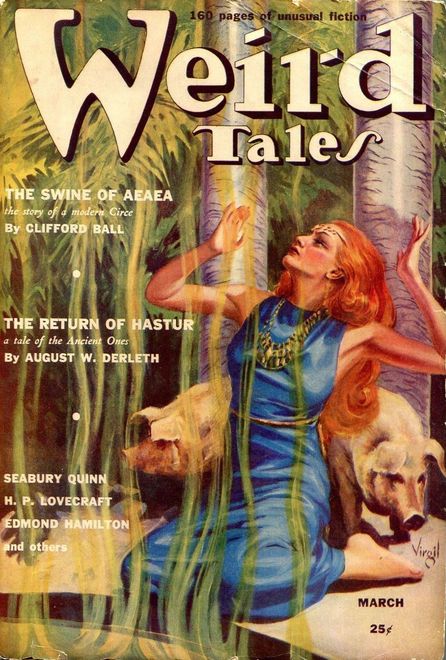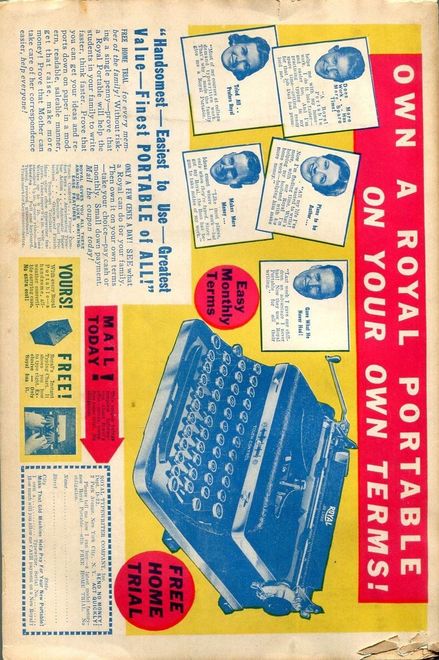Birthday Reviews: August Derleth’s “The Return of Hastur”
 |
 |
Cover by Virgil Finlay
August Derleth was born on February 24, 1909 and died on July 4, 1971. It was Derleth who coined the term “Cthulhu Mythos” for H.P. Lovecraft’s stories, although Derleth had earlier suggested the “Hastur Mythology,” which Lovecraft rejected.
In 1939, Derleth and Donald Wandrei founded Arkham House, a small press dedicated to preserving the writings of H.P. Lovecraft, and eventually those who were influenced by Lovecraft.
Although best known as a proponent of Lovecraft and for his own stories which expand on Lovecraft’s work, Derleth also wrote children’s books and biographies aimed at kids and detective fiction, most notable the Solar Pons series. He felt his Sac Prairie saga, which was based on Sauk City, Wisconsin, where he lived, was his most important work.
“The Return of Hastur” was purchased by Farnsworth Wright and appeared in the March 1939 issue of Weird Tales, which also included a story by Lovecraft. Derleth reprinted the story in his collection Someone in the Dark in 1941 and again in The Mask of Cthulhu in 1958. Lin Carter selected the story for The Spawn of Cthulhu and it was eventually included in Robert M. Price’s The Hastur Cycle. It was included in the Barnes and Noble collection of Derleth stories The Cthulhu Mythos and in In Lovecraft’s Shadows: The Cthulhu Mythos Stories of August Derleth, issued by Arkham House in 1998. The story has been translated into French, Italian, and German. Lovecraft is known to have read and commented on an early version.
Derleth builds his story using the common tropes of a Lovecraftian tale. His narrator, Haddon, is an attorney for Amos Tuttle, lying on his death bed in a large mansion in Arkham. Amos implores Haddon to follow his will to the letter, including the destruction of certain books and the mansion. Although Haddon agrees, once Amos is dead, he acquiesces to Amos’s heir, Paul, to leave the house standing and allow Paul access to the books. Naturally, Paul learns about the various aspects of the Cthulhu mythos, particularly about Hastur, who returns as forewarned in the title.
“The Return of Hastur” seems to have been written with the fannish audience in mind, with an appearance by a watered-down Necronomicon, allusions to the events of “The Shadows over Innsmouth,” and direct references to H.P. Lovecraft and “The Call of Cthulhu.” Paul Tuttle, who is working on a “Sac treatise” may very well be a marysue for Derleth, although Derleth also includes a reference to the Comte d’Erlette, Lovecraft’s own alter ego for Derleth, in the story. Although Derleth has adopted the overwritten style of Lovecraft, he does not incorporate the sense of insanity that often arises in Lovecraft’s stories. In the end, “The Return of Hastur” reads like fan fiction rather than a professional tale.
Reprint reviewed in the collection The Mask of Cthulhu, Caroroll and Graf, 1996.
 Steven H Silver is a fifteen-time Hugo Award nominee and was the publisher of the Hugo-nominated fanzine Argentus as well as the editor and publisher of ISFiC Press for 8 years. He has also edited books for DAW and NESFA Press. He began publishing short fiction in 2008 and his most recently published story is “Big White Men—Attack!” in Little Green Men—Attack! Steven has chaired the first Midwest Construction, Windycon three times, and the SFWA Nebula Conference 5 times, as well as serving as the Event Coordinator for SFWA. He was programming chair for Chicon 2000 and Vice Chair of Chicon 7. He has been the news editor for SF Site since 2002.
Steven H Silver is a fifteen-time Hugo Award nominee and was the publisher of the Hugo-nominated fanzine Argentus as well as the editor and publisher of ISFiC Press for 8 years. He has also edited books for DAW and NESFA Press. He began publishing short fiction in 2008 and his most recently published story is “Big White Men—Attack!” in Little Green Men—Attack! Steven has chaired the first Midwest Construction, Windycon three times, and the SFWA Nebula Conference 5 times, as well as serving as the Event Coordinator for SFWA. He was programming chair for Chicon 2000 and Vice Chair of Chicon 7. He has been the news editor for SF Site since 2002.
Could that have been a source for Marion Zimmer Bradley’s Darkover family name Hastur, I wonder?
Wasn’t Hastur a name derived from something by Ambrose Bierce?
Yes, Hastur was originally mentioned in Bierce’s story “Haïta the Shepherd” and was also mentioned in Chambers’s “The Yellow Sign.” Hastur was a god in Bierce’s work and a city in Chambers’s. Lovecraft mentioned Hastur in “The Whisperer in Darkness” and Derleth brought Hastur into the fullness of the mythos.
As for Rich’s question, since Bradley has included references to Lake Hali and Carcosa in her Darkover series, I think we can safely assume that she was paying tribute to the Lovecraftian mythos, including the works of Derleth.
I don’t much like saying anything about MZB given what’s now known about her domestic life, but — FWIW she wrote an article called “The (Bastard) Children of Hastur.”
http://www.wikithulhu.com/article:the-bastard-children-of-hastur
But any proximity of “Marion Zimmer Bradley” and “children” is about enough to make one throw up.